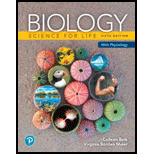
Biology: Science for Life with Physiology (6th Edition) (Belk, Border & Maier, The Biology: Science for Life Series, 5th Edition)
6th Edition
ISBN: 9780134555430
Author: Colleen Belk, Virginia Borden Maier
Publisher: PEARSON
expand_more
expand_more
format_list_bulleted
Question
Chapter 2, Problem 5LTB
Summary Introduction
Introduction:
Particles which are smaller in size than the atom are known as subatomic particles. The three chief subatomic particles which form an atom are neutrons,electrons, and protons. The center of the atom is known as the nucleus. The nucleus of an atom is formed by the protons and neutrons. It is known as the atomic nucleus.
Expert Solution & Answer
Want to see the full answer?
Check out a sample textbook solution
Students have asked these similar questions
Part A
Which of the following is NOTa subatomic particle?
molecule
O neutron
proton
electron
an atom (to form cations) or adding electrons (to form anions). Ions are never formed by
1. It is important to recognize that ions are always formed by removing electrons from
a. There must be both positive ions (cations) and negative ions (anions) present.
2. It is very important to remember that a chemical compound must have a net charge
Read the following sentences.
changing the number of protons in an atom's nucleus.
of zero. This means that if a compound contains ions, then
a
The subatomic particle
is located in the
A
has a positive charge and
A
Chapter 2 Solutions
Biology: Science for Life with Physiology (6th Edition) (Belk, Border & Maier, The Biology: Science for Life Series, 5th Edition)
Ch. 2 - Prob. 1LTBCh. 2 - Prob. 2LTBCh. 2 - Add labels to the figure that follows, which...Ch. 2 - Prob. 4LTBCh. 2 - Prob. 5LTBCh. 2 - Which of the following terms is least like the...Ch. 2 - Different proteins are composed of different...Ch. 2 - Proteins may function as ___________ genetic...Ch. 2 - Prob. 9LTBCh. 2 - Eukaryotic cells differ from prokaryotic cells in...
Ch. 2 - Which of the following lists the chemical bonds...Ch. 2 - Which of the following is not consistent with...Ch. 2 - Consider a virus composed of a protein coat...Ch. 2 - Prob. 2AAATBCh. 2 - Carbon, oxygen, hydrogen, and nitrogen are common...Ch. 2 - List some alternate explanations that should be...Ch. 2 - Do some web-based research using scientifically...Ch. 2 - Prob. 1MTC
Knowledge Booster
Similar questions
- ________ atoms give organic molecules their overall shape; ________ atoms determine the overall chemical behavior of organic molecules.arrow_forwardThe smallest unit of matter that retains the properties of their specific type of matter:arrow_forwardIn general, electrons far from the nucleus have more potential (chemical) energy than electrons closer to the nucleus in the same atom. True Falsearrow_forward
- _____________ compounds exclude water.arrow_forwardA solution with pH 4 has __________ the H+ concentration of pH 8.arrow_forwardWhich of the following is not a fundamental subatomic particle that forms elements? Which of the following is not a fundamental subatomic particle that forms elements? electrons protons nucleus neutronsarrow_forward
- Why the Number of Electrons Matter Since we know each element as a defined number of protons, we can also use that number to determine the number of electrons, assuming the element has no charge. Let’s write some out: ELEMENT NUMBER OF PROTONS NUMBER OF ELECTRONS C A B O C D Al E F Na G H Si I Jarrow_forwardFree radicals are highly reactive molecules that often contain ________. They are reactive due to the presence of a single ________ that can cause a chain reaction of free radical formation. I need help finding the right words for the blanks. The second blank is a subatomic particle.arrow_forward_______ is an organized structure formed when phospholipids are mixed with waterarrow_forward
arrow_back_ios
SEE MORE QUESTIONS
arrow_forward_ios
Recommended textbooks for you

